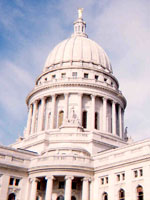
 This article is published courtesy of the January 2010 State Bar De Novo newsletter, published by the Appellate Practice Law Section
This article is published courtesy of the January 2010 State Bar De Novo newsletter, published by the Appellate Practice Law Section
Feb. 17, 2010 – Many hot-button issues in the legal world come directly before the Wisconsin Supreme Court without having worked their way through the court system. Such issues have included the diploma privilege, judicial recusal, and citation to unpublished decisions. The supreme court decides these issues and many others through the rule-making process pursuant to the court’s general authority to regulate the practice of law in Wisconsin. This article attempts to demystify that process, provide some guidance to parties interested in petitioning the supreme court for the amendment or creation of a rule, and highlight some recent changes in the rule-making process.
Authority
The supreme court’s rule-making authority is derived from Article VII, § 3 of the Wisconsin Constitution and Section 751.12 of the Wisconsin Statutes. Pursuant to Article VII, § 3 of the state Constitution, the supreme court has “superintending and administrative authority over all courts.” This constitutional grant of power “has been described as establishing ‘a duty of the supreme court to exercise . . . administrative authority to promote the efficient and effective operation of the state’s court system.’”1 Further, Wis. Stat. § 751.12(1) confers upon the supreme court the power to “regulate pleading, practice, and procedure in judicial proceedings in all courts . . . .” Collectively, this authority is referred to as the court’s regulatory jurisdiction.
Matters within the supreme court’s regulatory jurisdiction include, but are not limited to: bar admission, continuing legal education, lawyer discipline, judicial discipline, Supreme Court Rules, and rules of pleading, practice and procedure in civil and criminal actions.2 Rules adopted by the supreme court are codified as either a Supreme Court Rule or as a statute.
While the supreme court has the authority to consider a vast array of issues pursuant to its regulatory jurisdiction, there is a limit. Specifically, Wis. Stat. § 751.12(1) provides that any rule adopted by the supreme court “shall not abridge, enlarge, or modify the substantive rights of any litigant.”
Process
To initiate the rule-making process, a party must petition the supreme court.3 In June of 2009, the supreme court created a cover sheet and guidelines to help lawyers navigate this process. The cover sheet and guidelines instruct the petitioner on what information and documents must be submitted as part of the petition.4 These new guidelines highlight that “[a]ny person” can petition the supreme court to adopt or amend a Supreme Court Rule, a rule of pleading and practice, or an administrative rule.5
The petitioner must submit three documents as part of the petition: (1) a cover sheet; (2) the actual petition; and (3) a memorandum in support of the petition. The cover sheet is a form that seeks pertinent information about the proposed rule or amendment—it contains blank spaces for answers and can be filled out on a computer. In addition, the cover sheet contains a section titled, “Guidelines for Rules Submissions,” which, as stated above, provides guidance for the petitioner to follow in submitting a petition. Next, the contents of the petition must include the text of the proposed rule and “[i]f the proposal amends an existing rule, statute, or administrative matter, deleted portions should be shown and stricken through followed by new text that should be underlined.” Lastly, the supporting memorandum must set forth, inter alia, the following: the rule that the party is seeking to create or amend; the reason for the petition; and, the potential impact or effect of the proposed rule or amendment.
The supreme court then reviews the petition. If the court finds the petition meritless, it may summarily dismiss the petition or decline to take any action.6 If, on the other hand, the court determines the petition has merit, it will give notice of and hold a public hearing on the creation or amendment of the rule that is proposed in the petition.7 In addition to the formal notice of the hearing, the supreme court also may send a letter to parties that may have an interest in the outcome of the petition. Such a letter invites the potentially interested parties to provide a written statement or to give testimony during the public hearing. For example, the supreme court may solicit input from, amongst others, the State Bar, the Judicial Council, and/or the deans of the Marquette University Law School and the University of Wisconsin Law School. However, any person may submit a written response or speak at the public hearing with regards to the workability or desirability of the pending petition.
The public hearing is conducted in a manner that is similar to an oral argument in a case that is reviewed by the court, in that the petitioner makes his or her argument before the justices and answers questions posed by the justices. In addition to being open to the public, the hearing, which is held in the Supreme Court Hearing Room, is recorded and the audio recording is available on the supreme court’s website. The audio and video recordings are also available on the Wisconsin Eye Web site.8
Following the public hearing, the supreme court meets in open conference in the Supreme Court Hearing Room to discuss the merits of and act on the petition. In conjunction with the notice of the hearing, the court provides notice of the conference. The conference typically takes place immediately after the hearing. The conference is similar to those the court holds when it is deciding a case except that it is open to the public. Essentially, the conference is an informal discussion amongst the justices on the merits of the petition. Each justice has a microphone during the conference so that the public can hear the discussion and so that it can be recorded. The audio and video recordings of the conference are available at the Wisconsin Eye Web site.
If the court believes it has thoroughly discussed the petition at the conference and is ready to decide, it will vote on whether to adopt the petition. If the court is unable to complete its discussion of the petition, or if the court adopts the petition in principle subject to a revision of the text of the proposed rule, it will adjourn the conference to a specific date and time. In the event the court does not set a new date and time at the conference, it will give notice once the new date and time are set.
Finally, the court will issue a written order granting or denying the petition. If the court grants the petition, the order will include the text of the new rule.9
Conclusion
The supreme court’s rule-making process gives a party the extraordinary power to directly change the Wisconsin Statutes and the Supreme Court Rules. Accordingly, this process should be kept in mind as it can be a very effective way to shape the practice of law in Wisconsin without having to endure the laborious process of getting legislation enacted through the Wisconsin State Legislature.
Adam S. Bazelon, Marquette 2007 cum laude, is an attorney with Meissner Tierney Fisher & Nichols S.C., Milwaukee. He maintains a civil litigation practice, focusing on business disputes, employment law, and insurance coverage matters.
This article is published courtesy of the January 2010 edition of DeNovo, published by the State Bar Appellate Practice Law Section. The State Bar offers its members the opportunity to network with other lawyers who share a common interest through its 26 sections. Section membership includes access to newsletters, email lists to facilitate information sharing, and other resources.
1State v. Jennings, 2002 WI 144, ¶ 14, 252 Wis. 2d 228, 647 N.W.2d 142 (quoting In re Grady, 118 Wis. 2d 762, 783, 348 N.W.2d 559 (1984)).
2Wisconsin Supreme Court Internal Operating Procedures (hereinafter referred to as “IOP”) II.B.5.
3The supreme court can also consider the creation or amendment of a rule on its own motion.
4The cover sheet and guidelines can be found at on the Wisconsin Supreme Court’s website.
5Petition for Rule-Making in the Supreme Court of Wisconsin, Guidelines for Rules Submission, p. 5 (citing Wis. Stat. § 751.12 and IOP II.B.5 and III).
6IOP, III.A.
7If the petition involves the amendment of a Supreme Court Rule, and the court, at its discretion, determines that the petition involves “ministerial or otherwise non-substantive matters” or “exigent circumstances exist,” the court may decide not to hold a public hearing. IOP III.A.
8The Wisconsin Eye Web site can be found at http://www.wiseye.org.
9See Supreme Court Rule 98.04.
